Booties are light slippers that are worn on the feet. newborns, and children under one year of age. In the warm season, light openwork booties perform only a decorative function, while in winter and autumn, made from natural fur and leather, they protect babies from the cold.
In most cases, expectant mothers knit booties for their children while they are still waiting for them to be born. Particular attention is paid to the choice of yarn, because babies’ skin is very delicate, and if the yarn “bites”, the child will be nervous and capricious. Delicate and soft plush yarn is best suited for these purposes.
Crochet plush yarn booties: features of creation
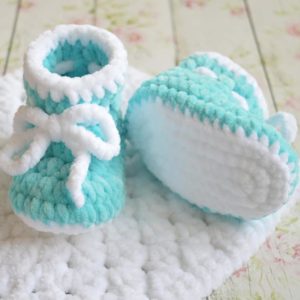 Plush yarn, which is most correctly called chenille, has many positive qualities for which This is what most needlewomen appreciate. Its main advantage is the softness and delicacy of knitted products that can be worn newborns children and people who cannot tolerate the touch of natural or synthetic hair to their body. In addition, plush:
Plush yarn, which is most correctly called chenille, has many positive qualities for which This is what most needlewomen appreciate. Its main advantage is the softness and delicacy of knitted products that can be worn newborns children and people who cannot tolerate the touch of natural or synthetic hair to their body. In addition, plush:
- very light;
- well suited for knitting relief patterns;
- very warm;
- universal, which allows you to use it to create children's things, toys, outerwear and interior accessories;
- presented in a wide variety of color shades.
When starting to work on plush booties, you need to take into account the following features of their creation and recommendations:
- Before starting work, you need to decide on the purpose of the slippers: whether they will be used for home wear or for going out for walks. In addition, it is worth considering that booties that are too thick will be hot in the summer and, conversely, booties that are thin will be cold in the winter.
- Today there are many schemes for creating children's slippers of this type in the form of bags, shoes or sneakers. The main thing is that the child feels comfortable, warm and safe in them.
- You should not decorate booties knitted for children who can already reach their feet with small decorative ornaments, as the baby can tear them off and swallow them.
- It is better to avoid internal seams, as they can cause irritation on delicate skin.
- Knitted slippers should not be too tight on the feet; the baby’s toes should remain free to move.
Advice! Knit indoor or outdoor slippers for newborns made from plush yarn is most comfortable on knitting needles. These threads are too soft for crochet.
If the choice still falls on the hook, it is better to use large tools.
Crochet booties for newborns from plush yarn: diagram and description
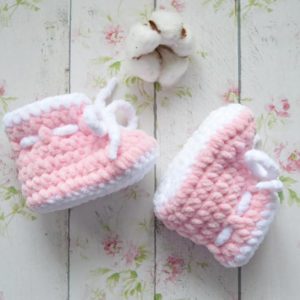 When planning to knit booties for a child from plush threads, first of all you need to stock up on the yarn itself. For things that children will wear, it is best to buy threads from the following well-known and trusted manufacturers:
When planning to knit booties for a child from plush threads, first of all you need to stock up on the yarn itself. For things that children will wear, it is best to buy threads from the following well-known and trusted manufacturers:
- "Alize". The Alize company produces two lines of plush threads: “Softy" And "Puffy" The first type has a delicate pile, the second consists of lush columns.
- "YarnArt". Like Alize, it produces two lines of plush - Dolce and Velor. They differ from each other in thread density.
- "Vita Fance" Yarn from Vita Fance“Although it is called “Plush”, its structure is still more reminiscent of terry.
After the yarn has been purchased, you can begin to work. For the first time, it is better to crochet a simple model of booties in the form of boots with a drawstring lace.
Important! It is best to start knitting booties from the sole.
Process step by step:
- 10 air loops (VP) are put on the hook.
- In the second loop from the hook, 8 stitches are knitted without yarn over (SBN).
- An increase of 4 RLS is knitted into the outermost VP and knitting continues along the reverse side of the resulting chain: 7 RLS, an increase of 3 RLS in the outer loop. As a result, 22 RLS should come out.
- The finished sole is connected to the first column of the row.
Important! Knitting is done in rows, not in spirals.
- The main part must be knitted according to the pattern below, in which each new row should begin with a VP and continue by tying the sole along the oval. The rows should end with a connecting column (CC) in the first column of the row.
Scheme:
- increase (PR) 7 RLS, 4 RLS, 7 RLS, 3 RLS – 30 RLS;
- SBN, PR, 7SBN, SBN. PR x4, 7СБН, СБН. PR x3 – 38 RLS;
- the color of the thread changes to the main one;
- 38 half columns With yarn over (PSSN) attached to the rear loop;
- 8 PRSN, 9 decreases (UB), 12 PRSN – 29 PRSN;
- 8 PSSN, 5 UB, 11 PSSN – 24 PSSN;
- 9 PSSN, 2 UB, 11 PSSN – 22 PSSN;
- alternating PSSN and VP, make holes for ties;
- 22 PSSN;
- They complete the process with a thread of a different color by tying it around the edge of the bootie.
Laces for ready-made and sewn booties are knitted with a small crochet by casting on 80 VP. To prevent the edges of the lace from fraying over time, you can set them on fire with a match.
Options for decorating and complementing booties made of plush yarn
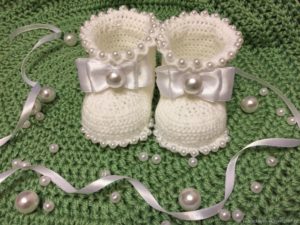 The choice of decorations for baby booties primarily depends on the gender of the child for whom they were knitted. Some useful ideas:
The choice of decorations for baby booties primarily depends on the gender of the child for whom they were knitted. Some useful ideas:
- Slippers designed for girls can be decorated with ribbons, lace or beads. Booties look elegant and festive when used as ties using wide satin ribbons tied in lush bows. You can also decorate your baby’s first shoes using knitted elements – hearts, flowers or long bunny ears.
- To decorate boys' booties, you can use buttons made in the shape of boats or anchors. Animal faces can be sewn onto the toes, which will further help develop the child’s attention and fine motor skills.
Ties with pompoms are considered a universal decoration option. You can make them from yarn of the same color as the booties themselves or choose a different color from it.


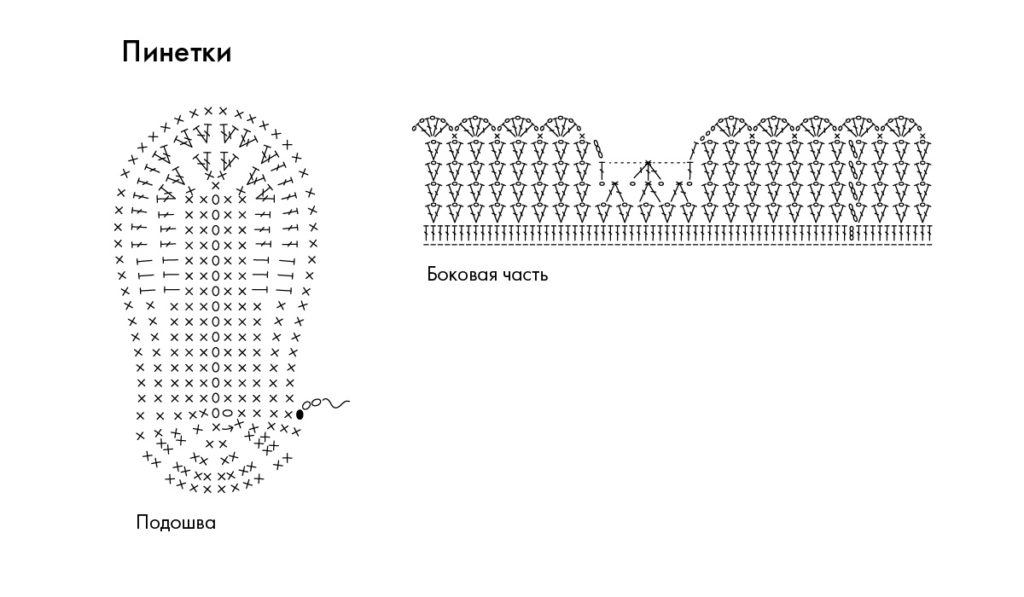
 0
0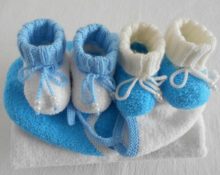
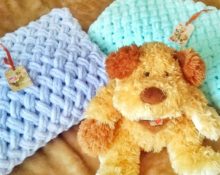

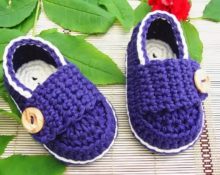
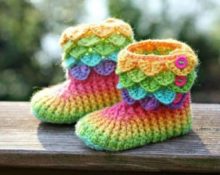
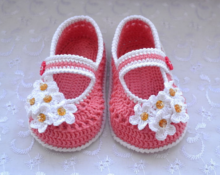

Hello. Are there any decreases for booties from hdc or sc?